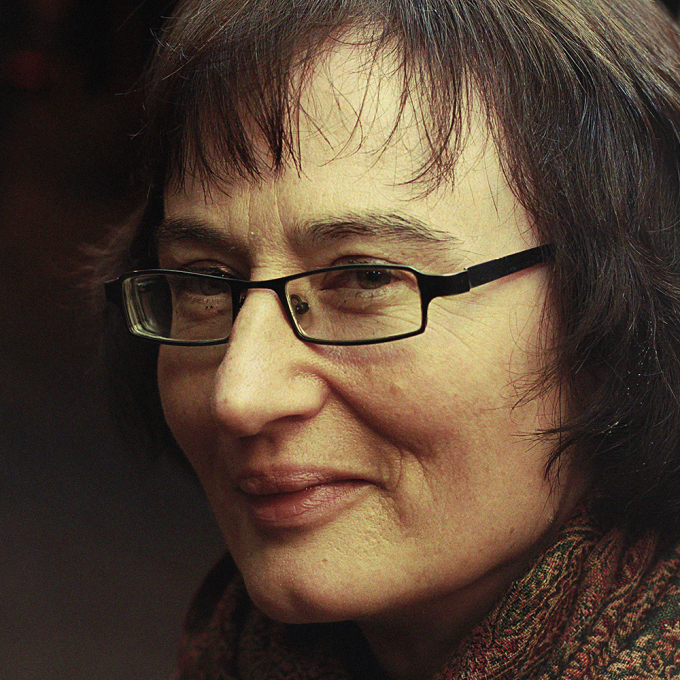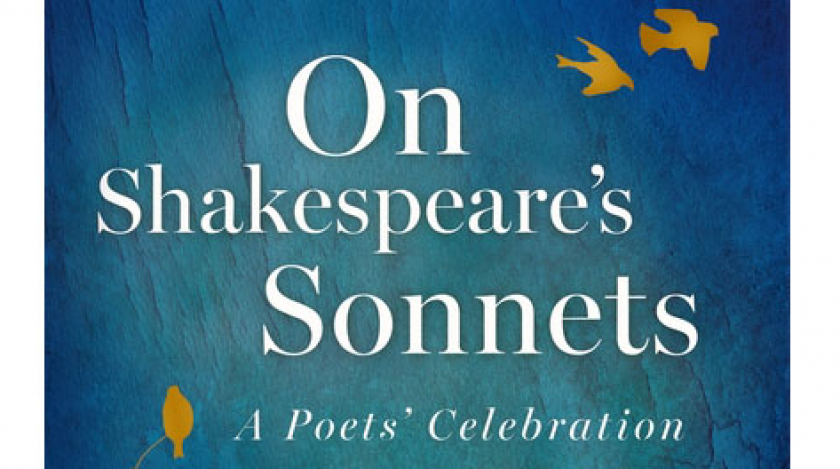
- ©
- Ekaterina Voskresenskaya
Biography
Fiona Sampson was born in London.
After a brief career as a concert violinist, she studied at Oxford University, where she won the Newdigate Prize. She has a PhD in the philosophy of language from Nijmegen University.
Her collections of poetry include Folding the Real (2001); The Distance Between Us (2005); Common Prayer (2007); and The Catch (2016). She was short-listed for the Forward Poetry Prize (Best Single Poem) in 2006.
She has written and edited several books on the theory of creative writing, including The Self on the Page: Theory and Practive of Creative Writing in Self Development (1998); The Healing World (1999); Creative Writing in Health and Social Care (2004); Writing: Self and Reflexivity (2005); On Listening (2007); and Writing Poetry (2009). Her study of musical form in poetry, Lyric Cousins, appeared in 2016.
Her books of translation include Evening Brings Everything Back (2004), and Collected Poems (2011), both by Jaan Kaplinski. She was co-editor of A Fine Line (2004), an anthology of new poetry from Eastern and Central Europe, and founder-editor of Orient Express, a journal of contemporary writing from the EU enlargement countries (2002-05). From 1995-2000, she directed Aberystwyth International Poetry Festival. Seven of her own books are published in translation. Patuvacki Dnevnik (Macedonia) received the 2004 Zlaten Prsten prize.
She is also known for her pioneering work involving creative writing and health care, and undertook long-term residencies in this field throughout the 1990s.
She collaborates with visual artists on commissions: with printmaker Meg Campbell on the artists' book Birth Chart (1993) and the exhibition My Grandmother, My Mother, Myself (1994); with stone-carver Alec Peever on public art work in Swindon (1993), High Wycombe (1995) and Slough (2008). The Memory Ship was commissioned by Ledbury Poetry Festival for a textile hanging in Ledbury Hospital (2002). She has also collaborated with Wanda Mihuleac and Jacques Rancourt on an artists' book, Attitudes de priere (Transignum, Paris, 2008) and with the Coull Quartet (2008).
From 2002-2005 she was the Arts and Humanities Research Council Research Fellow at Oxford Brookes University; for 2007-2008 she is Fellow in Creativity at the University of Warwick. Since 2005, she has been the editor of Poetry Review and in 2009, edited the Poetry Book Society Recommended A Century of Poetry Review. She contriubtes regularly to radio and to a number of publications, including The Guardian, the Irish Times and The Liberal.
Fiona Sampson received a Cholmondeley Award in 2009. Her latest collection of poetry, Rough Music (2010) was shortlisted for the 2010 Forward Poetry Prize (Best Poetry Collection of the Year) and the 2010 T. S. Eliot Prize. In 2011 she was elected a Fellow and a Council Member of the Royal Society of Literature. She received an MBE for services to literature in the Queen's New Year's Honours list.
Critical perspective
Fiona Sampson is the current editor of Poetry Review, the magazine of the Poetry Society in London, and has opened it up to international perspectives.
Her editorial in the Autumn 2007 issue, which celebrated the flowering of a recent ‘translation culture’ amongst leading British poets, states that ‘International writing is the context of excellence in which the best British poetry sits; P[oetry] R[eview] is committed to this vision’. She was previously a founding editor of Orient Express, a magazine of writing in translation from ‘enlargement Europe’ and has herself translated works such as Jaan Kaplinski’s Evening Brings Everything Back (2004). International writing is certainly the context in which her own poetry collections, Folding the Real (2001), The Distance Between Us (2005) and Common Prayer (2007), are most readily understood. These are a world away from mainstream poetry fashion, instead offering intellectually challenging but also emotional journeys, full of brilliantly unusual images and metaphors – often appropriated from linguistics, music and especially her religious faith.
The intellectual background to her multi-faceted work as an editor, poet and translator is unusual to say the least. Firstly, she has a doctorate in the philosophy of language. She has also had a high-level musical training. In her poems, music falls ‘like leaves’, and images of the violin’s ‘blind belly’, the piano’s ‘lucent shellac’, feature regularly alongside verbal snapshots of herself as a ‘kid / practicing endlessly, behind drawn curtains’ (‘The Velvet Shutter’). The experience of playing music seems to inform her concept of writing as a tightly-knit physical and mental process, even when things go wrong: ‘When a string breaks / pitches explode / spiral to silence / a flight of harmonic geese’ (ibid.). Composers and their music (even the ‘bell-like notes of John Cage’) offer her a way to consider the divine, and creativity itself. For instance, her homage to a Beethoven Quartet in ‘Attitudes of Prayer’ hails the work as ‘One hundred and thirty-one approaches / to the problem of God’, and imagines the composer ‘over and over / rehearsing what you don’t know, / soundlessly’ while struggling to transcribe ‘through the pall of tinnitus’. And ‘Messiaen’s Piano’ again alludes to the spiritual concerns of a composer, the music throwing ‘notes like handfuls of stones / to clatter / against a glass- / house God’.
Another side of Sampson’s work is a long-standing involvement with teaching creative writing, which, she observes, ‘affords the chance to juxtapose humour and reflection, the personal with the abstract’. Her particular expertise is in its therapeutic uses within healthcare, working with patients in hospitals or people with disabilities in day-care centres. She has referred to poetry as offering ‘a series of escape hatches’ in such places. In The Self on the Page: Theory and Practice of Creative Writing in Personal Development (1998), a collection of essays she co-edited, she looks at writing produced by people with Down’s Syndrome, and the elderly with dementia, noting how they can ‘take off the ‘pyjamas’ of institutionalized expectation and assume their own discursive authority’. Writing: Self and Reflexivity (2005) also deals with both practical and theoretical approaches to writing. A recent collection of her critical essays, On Listening (2007), is likewise concerned with issues around creative writing, community writing projects, as well as her interest in the problems of translation.
Sections of The Distance Between Us (2005) first appeared in Macedonian and in Eastern European magazines - aptly, for a work whose narrative moves across Europe, from Andalucian folksongs to characters in a Belgrade park. Its title may suggest that the distance between two people in a love affair – culturally and emotionally - is crucial to their understanding. The opening section, ‘Cante Jondo’ (meaning ‘deep song’) interpolates lines from flamenco, and describes the lovers as ‘Two people / just coming to a halt’) in a desert landscape. T.S. Eliot comes to mind. Indeed, Sampson’s modernistic use of irregular lines, her religious and philosophical bent, and some specific Waste Land allusions (‘who’s the third’, ‘O O’) rather confirm this. Sampson’s other source of resonant reference tends to be from prayers or the Bible, at times mixed disconcertingly with sensuality. Of course, her picture of sexual intimacy is very un-Eliot-like: ‘To enter you / or me / is to enter a forest / where everything’s alive. / Leaves stirring with private gesture’ (‘Mid-journey’). After a ‘Turkish rondo’, the lovers find each other again in ‘the grotesque elegant city’ and a hotel bedroom. Yet there is no conventional happy ending. Instead they feel themselves reaching ‘out and beyond our bodies // pulling truth out of our selves out of reach / into pain’.
Her most recent collection, Common Prayer, was short-listed for the T.S. Eliot prize and praised by John Burnside and John Kinsella (notable poets with whom her work has some affinities). Conspicuous for its religious references, it emphasizes the treatment of bodies – whether of lovers or of loved ones beset by illness in hospital. The tone of the book overall is one of celebrating creation. ‘A Sacrament of Watering’ for instance presents a marvellously realized wren ,‘her green breasts appearing among leaves, / her feet narrow as rays’. The epigraph to ‘Trumpeldor Beach’, which was short-listed for the Forward Poetry Prize (Best Single Poem), is from Matthew Arnold’s ‘Dover Beach’. This might suggest a poem of religious doubt, but its brilliantly light-filled scene on ‘this mercurial Med’ [Mediterranean] seems affirmative. Its opening description of waves breaking on sand is again inherently musical: ‘a rhythmic / exhalation’. Standing on the beach is – oneself, amidst others, ‘One moment after another / taking you up / and dropping you’. Light is a favourite word throughout Sampson’s poetry, and here the speaker perceives, in the interplay of light and water, ‘fictional angels, / these bursts of supra-natural radiance’.
The other outstanding poem is ‘Scenes from the Miracle Cabinet’, whose speaker accompanies a patient to an operation. In a truly miraculous musical image, ‘Floor by floor and key by key, the lift / tunes the hospital’. Biblical language is interpolated (‘Saw ye him whom my soul loveth?’) and addresses itself to ‘your smoker’s body, / which I want to touch / with all the artifices of compassion’. In ‘The Enabled Voice’, an essay written for the Ledbury Poetry Festival about her experience of working with patients, Fiona Sampson refers to language itself as ‘a world we enter and move around in with pleasure because it is so full of possibility’. Her own work as a poet, editor, and translator, suggests this and makes her an energetic presence within current British writing, with valuable international perspectives.
Dr Jules Smith, 2008
Bibliography
Awards
Author statement
My first life as a violinist meant I’d always feel part of a wider European, rather than simply national, culture. An interest in poetry in translation arose naturally from this, extended beyond the European, and has exposed me to many extraordinary influences. Beauty and risk, the title I gave a recent issue of Poetry Review, has become a personal motto. Embarrassing to admit, it’s only more recently I’ve realised how important music continues to be. I’d love to be able to produce abstract form, as music does. Still, every poem starts out as an exploration – of the world of experience. Is this a contradiction? I don’t think so. I think making probably goes on in both these ways, and at once. Doesn’t it?

